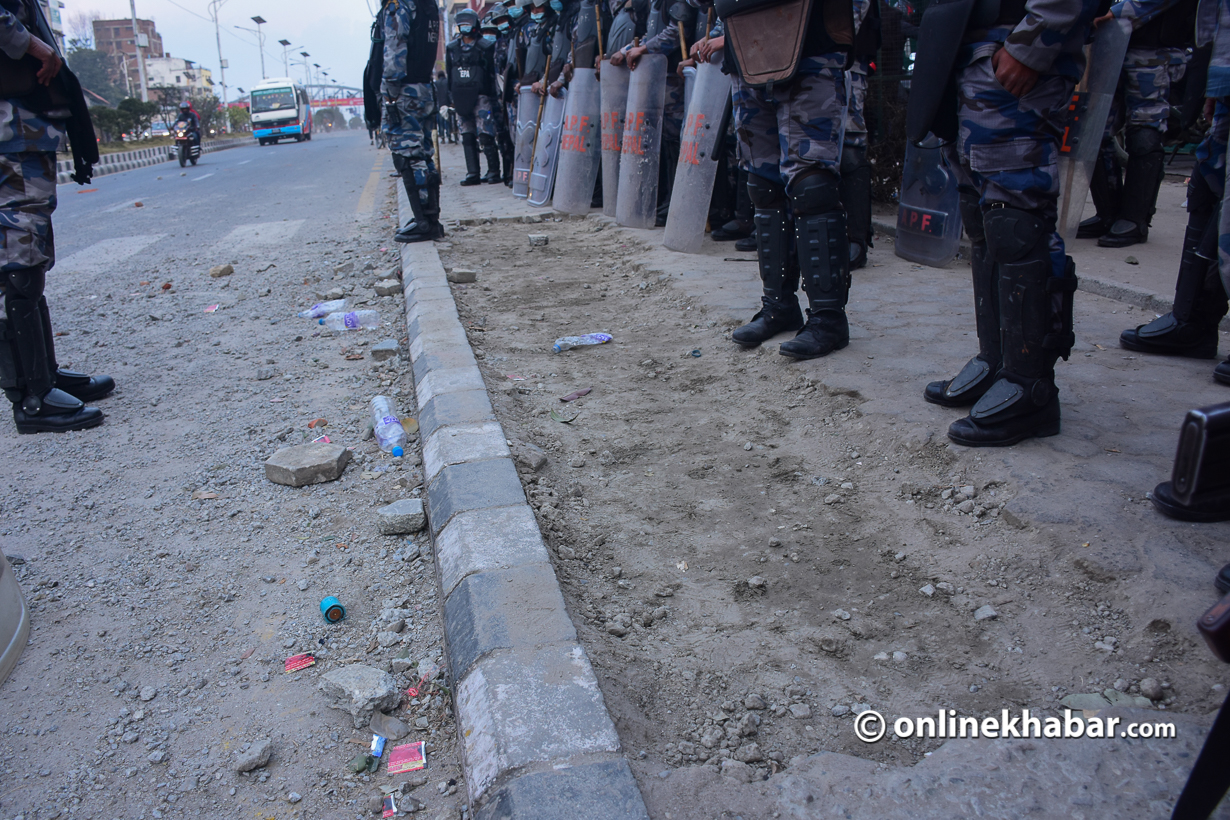On Sunday, when the government tabled the controversial Millennium Challenge Corporation Compact (MCC deal) signed with the United States government in 2017 in the House of Representatives, the Naya Baneshwar area in Kathmandu turned into a battlefield. During clashes between protesters demonstrating against the US government’s MCC deal and the police, the crowd has spared no efforts to vandalise road infrastructures such as pedestrian pavements, green strips and railings. Consequently, returning to the place on the next day, the scene was enough to have an idea of loss and damage.
Even after the Kathmandu metropolitan city cleaned up the road, pieces of stones, bricks and concrete, broken sticks and green twigs of trees and plants could be seen along the roadside.
The items used to attack the police were not brought from anywhere. In fact, the protesters used the roads, pavements, dividers, and trees planted there among other road infrastructures as ‘weapons’.
This incident once again highlighted the need for changing the way Nepalis stage protests.
The wrong way

Probably there are none who like the way protestors vandalised the road infrastructures finally constructed after almost a decade of Maitighar-Tinkune road expansion, and destroying the plants and trees that were planted a decade ago.
Rameshwar Sunar, a security guard at a bank in Baneshwar, says he did not know what good the protest brought but was shocked by the movement’s brutal style and attack on public property.
Before his eyes, the tiles of the pavements were uprooted and thrown on the road to break them into pieces and the police were attacked with that. He said that no one in the crowd of the so-called ‘learned and educated’ youth stood out and said this should not have been done.
“Even ordinary people like me know that such a destructive act against road infrastructures is not a good thing to do,” he says, “This vandalisation is the result of the government’s habit of ignoring issues until the crowd protests violently like this.”
Tiles have been removed in many places of the pedestrian pavements of the Baneshwar area. They have also dug holes on road infrastructures to remove the tiles, with which they attacked the police.
According to Radheshyam Mandal, a clothing store owner in Baneshwar, several internet socket boxes on the roadside poles got destroyed due to stones and tiles thrown by the protesters and the internet did not work till Monday afternoon. He says, “It is better that no one does protest like this causing problems for the common people.”
Not only the shopkeepers but also the pedestrians passing through Baneshwar suggest protestors demonstrate peacefully considering public property including road infrastructures as their own.
Ramila Dawadi of Buddhanagar, who was returning from shopping in Baneshwar on Sunday, says, “Anger against anyone should not be poured on the common property that everyone needs. Why destroy and ruin the road infrastructures made from taxes paid by people’s hard-earned money?”
No green, no gain
The protesters have vandalised not only the pavement but also the green strip that divides different lanes of the main road.
The chief of the Kathmandu Road Division Office, Narayan Niure, says it is sad to see protesters making the road infrastructures the main target.
“The government has to spend so much of time and human resources and investment to rebuild the vandalised public structures,” he says, “ This puts a strain on the government and the taxpayers.”
The road infrastructures in Kathmandu are already in a poor condition and are comfortable for all. On top of that, the act of removing tiles, resulting in holes on the pavements, has become a matter of shame for the protestors themselves.
“It is the duty of all to keep the pavements where the children, the elderly, and the disabled walk, in good condition,” says Niure, “Such violent acts benefit none, not even the protestors themselves.”

The protesters have also damaged trees in the middle of the road and on the side. In some places, the trees and plants have been uprooted from the base and in some places, the branches have been cut off.
The Maitighar-Baneshwar section is the greenest model road in Kathmandu. It was the result of years of hard work and maintenance. in the run-up to the SAARC Summit in 2014, trees and shrubs were planted on this road spending millions.
Initially, the damage was done by careless four-wheelers and pedestrians crossing the road carelessly. The police had patrolled and helped the Kathmandu metropolitan city grow the plants after they were criticised on social media saying the plants were in a state of dying.
The metropolitan city had entered into an agreement with Nepal Telecom to promote greenery around road infrastructures on the condition that it would be allowed to have advertisement boards. Accordingly, Nepal Telecom has been working for the last five years in the field of greenery maintenance. After the expiration of the agreement, the environment department of the city has been conserving the greenery of this section.
Sarita Rai, acting head of the department, says, “Every citizen has a responsibility to make the city better.”
Rai adds, “One has to think before they pluck a plant that has been maintained around road infrastructures with a decade-long effort of the city. It will take another 10 years for such a plant to grow again.”




















